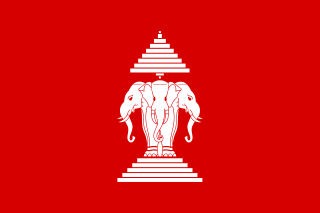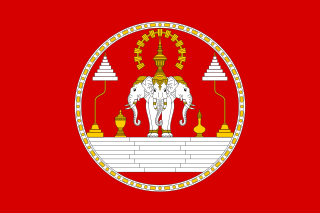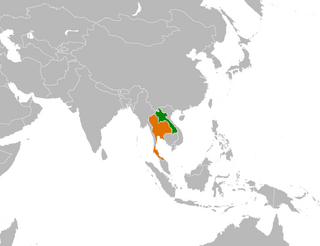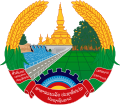
The politics of the Lao People's Democratic Republic takes place in the framework of a one-party socialist republic. The only legal political party is the Lao People's Revolutionary Party (LPRP). The de jure head of state is President Bounnhang Vorachith. The head of government is Prime Minister Thongloun Sisoulith, who is also the LPRP general secretary, making him the de facto leader of Laos.

Kaysone Phomvihane was the first leader of the Communist Lao People's Revolutionary Party from 1955 until his death in 1992. After the Communists seized power in the wake of the Laotian Civil War, he was the de facto leader of Laos from 1975 until his death. He served as the first Prime Minister of the Lao People's Democratic Republic from 1975 to 1991 and then as the second President from 1991 to 1992.

The Kingdom of Laos was a constitutional monarchy that served Laos beginning with its independence on 9 November 1953. The monarchy survived until December 1975, when its last king, Savang Vatthana, surrendered the throne to the Pathet Lao, who abolished the monarchy in favour of a Marxist–Leninist state called the Lao People's Democratic Republic, which has controlled Laos ever since.

Prince Phetsarath Ratanavongsa (Somdej Chao Maha Uparaja Petsaraj Ratanavongsa was the 1st Prime Minister of Luang Phrabang in French Laos from 21 August 1941 to 10 October 1945, and Head of State of Laos between 12 October 1945 and 4 April 1946.

Prince Souvanna Phouma was the leader of the neutralist faction and Prime Minister of the Kingdom of Laos several times.

Sisavang Vatthana or sometimes Savang Vatthana was the last king of the Kingdom of Laos and the 6th Prime Minister of Laos serving from 29 October to 21 November 1951. He ruled from 1959 after his father's death until his forced abdication in 1975. His rule ended with the takeover by the Pathet Lao in 1975, after which he and his family were sent to a re-education camp by the new government.

The Pathet Lao, officially the Lao People's Liberation Army, was a communist political movement and organization in Laos, formed in the mid-20th century. The group was ultimately successful in assuming political power in 1975, after the Laotian Civil War. The Pathet Lao were always closely associated with Vietnamese communists. During the civil war, it was effectively organized, equipped and even led by the People's Army of Vietnam (PAVN). They fought against the anti-communist forces in the Vietnam War. Eventually, the term became the generic name for Laotian communists.

The Laotian Civil War (1959–1975) was a civil war in Laos which was waged between the Communist Pathet Lao and the Royal Lao Government from 23 May 1959 to 2 December 1975. It is associated with the Cambodian Civil War and the Vietnam War, with both sides receiving heavy external support in a proxy war between the global Cold War superpowers. It is called the Secret War among the CIA Special Activities Center and Hmong veterans of the conflict.

Nouhak Phoumsavanh or Phoumsavan was a longtime Pathet Lao revolutionary and communist party official who was the 3rd President of Laos from 1992 to 1998.

Bounnhang Vorachith is a Laotian politician. He was previously General Secretary of the Lao People's Revolutionary Party and President of Laos from 2016 to 2021.

The President of the Lao People's Democratic Republic is the head of state of Laos. The current president is Thongloun Sisoulith, since 22 March 2021. He was previously elected as the General Secretary of the Lao People's Revolutionary Party in January 2021, ranking him first in the Politburo.

The Prime Minister of Laos, formerly the Chairman of the Council of Government of the Lao People's Democratic Republic, is the head of government of Laos. The highest position in the government, he or she directs the country's executive branch. The Prime Minister is accountable to the President, the National Assembly and the country's only legal party: the Lao People's Revolutionary Party (LPRP). The current Prime Minister is Phankham Viphavan, who was elected in 2021.
This article details the history of Laos since 1945.

The French protectorate of Laos was a French protectorate in Southeast Asia of what is today Laos between 1893 and 1953—with a brief interregnum as a Japanese puppet state in 1945—which constituted part of French Indochina. It was established over the Siamese vassal, the Kingdom of Luang Phrabang, following the Franco-Siamese War in 1893. It was integrated into French Indochina and in the following years further Siamese vassals, the Principality of Phuan and Kingdom of Champasak, were annexed into it in 1899 and 1904, respectively.

The Royal Lao Government was the ruling authority in the Kingdom of Laos from 1947 until the communist seizure of power in December 1975 and the proclamation of the Lao People's Democratic Republic. The Franco-Lao Treaty of 1953 gave Laos full independence but the following years were marked by a rivalry between the neutralists under Prince Souvanna Phouma, the right wing under Prince Boun Oum of Champassak, and the left-wing, Lao Patriotic Front under Prince Souphanouvong and future Prime Minister Kaysone Phomvihane. During this period, a number of unsuccessful attempts were made to establish coalition governments.

Laos and Thailand have had bilateral relations since the time of their precursor Lan Xang and Ayutthaya kingdoms in the 15th century. The two countries share a border and express linguistic and cultural similarities. The Lao kingdom of Lan Xang included all of northeastern Thailand as recently as the early 18th century. Thailand's northeastern region, Isan, has particularly strong Lao roots. Linguistically, the inhabitants of Isan, a third of the Thai population, speak the Isan language, a Lao dialect. Diplomacy has concentrated on the Mekong River, seeking to make it a "river of true peace and friendship", as made explicit in statements by both respective prime ministers in 1976.

The Lao Issara was an anti-French, non-communist nationalist movement formed on 12 October 1945 by Prince Phetsarath. This short-lived movement emerged after the Japanese defeat in World War II and became the government of Laos before the return of the French. It aimed to prevent the French from restoring their control over Laos. The group disbanded in 1949.
Katay Don Sasorith was a Laotian nationalist, politician, author, and the 8th Prime Minister of Laos.
Phankham Viphavanh is a Laotian politician, a member of Politburo and Executive Committee of the Lao People's Revolutionary Party. He is also the current Prime Minister of Laos, who was elected by the National Assembly of Laos in April 2016.Previously, he was Vice President of Laos, Minister of Education of Laos, and President of the Lao–Vietnam Friendship Association.
The 1964 Laotian coups were two attempted coup d'etats against the Royal Lao Government. The 18 April 1964 coup was notable for being committed by the policemen of the Directorate of National Coordination. Although successful, it was overturned five days later by U.S. Ambassador Leonard Unger. In its wake, Neutralist Prime Minister Souvanna Phouma forged a fragile coalition with the Pathet Lao communists. On 4 August 1964, Defense Minister Phoumi Nosavan attempted to take over Vientiane with a training battalion. This coup was quickly crushed by the local Royal Lao Army troops, as the police sat out the conflict.














